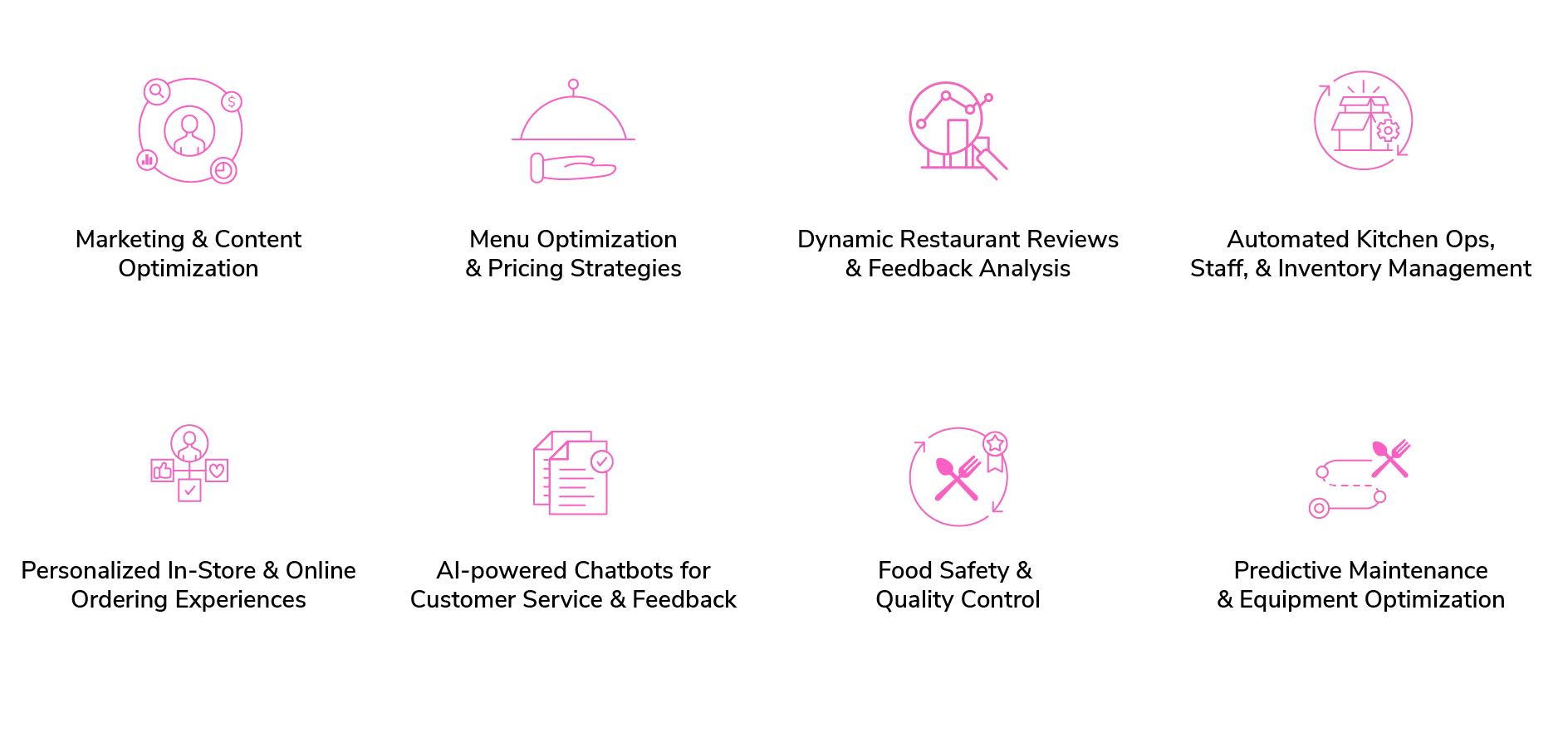AI You Can Eat: How AI is Transforming Restaurants

When ChatGPT debuted in late 2022, it sparked universal interest in Generative AI, both on personal and professional levels. Could “the machines” help us write better resumes or come up with the perfect birthday gift for quirky Uncle Wayne? Could we use it as a stand-in therapist or to generate hilarious images of a bear eating pizza on a surfboard?
We began to wonder: what could technology enable us to do better, smarter, faster?
While AI has been around for decades, brands are starting to explore AI applications and how to justify investing in this (re)emerging technology. It’s transforming the way we work and live. From self-serve kiosks to inventory management to scheduling, AI is an indispensable tool for restaurants.
In particular, we’ve seen restaurant brands apply AI to their businesses in three core areas:
- Marketing Optimization: Brands are leveraging thousands of inputs to confidently understand which marketing programs are effective, then scale these insights to deliver personalized content. On a small scale, our restaurant clients are testing AI-generated email subject lines and pre-headers and are allowing AI to write paid media ad copy. Results from each campaign help the AI tools learn and make smarter, data-driven copy recommendations.
- Experience Optimization: AI can uncover the customer experiences that are most impactful, while rigorously testing and validating through controlled studies. Across eCommerce platforms, product recommendations or upsell modules based on behavioral cues and AI outputs generate more add-to-carts and purchases. For dining clients, NomNom, our proprietary recommendation engine, is built on AI. One client saw a 50% lift in recommended items purchased and a 0.8% lift in digital revenue, all from implementing AI-powered product recommendations.
- Operational Efficiency: Perhaps the most intuitive AI application is how brands can develop tools and processes that help their teams work effectively and improve their operational workload. Brands are exploring how AI can help detect customer sentiment, and make recommendations for improvements, based not only on in-store interactions, but also back-of-house data.
Each application is built on a foundation of data and analytics, unlocking real-time insights and business intelligence to drive enhanced decision making.
AI for Restaurants
Using data to improve or automate certain elements of a customer journey isn’t necessarily new. For years, brands have used AI in small ways—product recommendations or in upsell modals, for example. With platforms and tools becoming more accessible and smarter, companies are pushing innovation even further, enabling marketers and other professionals to leverage AI without needing a data scientist for many use cases.
Brands within the restaurant industry are especially interested in adopting and testing applications of AI—both to improve the customer experience and to streamline back-of-house operations. In fact, 41% of U.S. restaurant operators plan to use AI for sales forecasting, with an additional 31% turning to AI for help with inventory and purchasing decisions. One third of restaurants plan to use AI to create and execute personalized marketing messages.
Maybe you’ve experienced this new wave of AI on your last visit to a QSR as an AI-order taker captured your drive-thru order at a Wendy’s, McDonalds or White Castle. Or perhaps you’ve noticed how Starbuck’s proprietary suite of AI tools, Deep Brew, makes subtle improvements on both sides of the counter: Your coffee is made quicker and stores are well-staffed, thanks to its personalized in-app recommendations and predictive staffing and inventory models.
How to Get Started with AI
Some brands, however, may feel overwhelmed with the sheer potential of AI. A good starting point is to consider what small tasks could be automated to free up your team to work more strategically and have more time to connect with customers.
Our advice is to brainstorm broadly, start small and continue testing. You may find AI improvements in areas you never considered between your content, marketing or technology teams.
If you’re a restaurant operator looking for ways to integrate AI into your work, here are a few places to get started:

Predicting the Predictives
Looking ahead, we have a few predictions about AI's impact on the restaurant industry.
First, we’ll see more tools and software continue integrating AI into native applications. The smarter our tools become around content, data and customer performance, the easier it’ll be to meaningfully apply those learnings.
Second, machines won’t replace human workers, despite early claims of workforce reduction. These AI models can recognize patterns and generate suggestions, but they’re only as good as their data inputs. Furthermore, some brands hold that AI tools are unable to connect with people the same way humans can, and during in-person visits where customer experiences are paramount, AI may not be a suitable human replacement.
Finally, with brands prioritizing investments and testing AI applications, we’ll continue to see innovations in this field. Leading companies will be those who embrace, apply and validate how AI can help them across their marketing, customer experiences and operational workflows.
"With the release of ChatGPT, AI has become more approachable to the masses. However, our clients often struggle to separate fact from fiction regarding Generative AI,” said Skyler Lauren, Director of Generative AI at Bounteous. “They quickly learn that seeing is not believing—doing is believing. Unlocking the true value of this technology requires a new approach and mindset. I've witnessed this firsthand with the tools we build for our team and the journeys we undertake to help clients develop their custom solutions."
As AI continues to evolve, brands should watch for and address gaps in their systems, then test AI technologies that align with their business goals. We’re looking forward to continuing to explore AI and keeping a close eye on this emerging field that has the potential to unlock some truly innovative growth.
Until then, I’m off to buy Uncle Wayne a funny t-shirt, novelty socks or a whimsical gadget–thanks for the suggestions, AI.